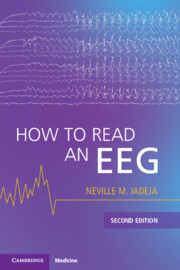Book contents
- How to Read an EEG
- Reviews
- How to Read an EEG
- Copyright page
- Dedication
- Contents
- Figure Contributions
- Foreword to the First Edition
- Preface
- How to Read This Book
- Part I Basics
- Chapter 1 Introduction
- Chapter 2 Polarity and Montages
- Chapter 3 Localization
- Chapter 4 Frequency and Rhythm
- Chapter 5 Maturation
- Chapter 6 Normal Adult EEG
- Part II Interpretation
- Part III Specific Conditions
- Appendix: How to Write a Report
- Index
- References
Chapter 1 - Introduction
from Part I - Basics
Published online by Cambridge University Press: 27 September 2025
- How to Read an EEG
- Reviews
- How to Read an EEG
- Copyright page
- Dedication
- Contents
- Figure Contributions
- Foreword to the First Edition
- Preface
- How to Read This Book
- Part I Basics
- Chapter 1 Introduction
- Chapter 2 Polarity and Montages
- Chapter 3 Localization
- Chapter 4 Frequency and Rhythm
- Chapter 5 Maturation
- Chapter 6 Normal Adult EEG
- Part II Interpretation
- Part III Specific Conditions
- Appendix: How to Write a Report
- Index
- References
Summary
This chapter introduces the reader to electroencephalography (EEG) including basic concepts, indications, limitations, placement of electrodes, instrument, display, parameters, calibration, safety, and the various types of EEG. EEGs are a commonly used test to evaluate various neurological conditions. Minute electrical potentials generated by neuronal synaptic activity in the superficial cerebral cortex can be detected by recording electrodes placed on the scalp, amplified, and displayed as electrographic waveforms on a screen. Subcortical structures such as the thalamus modulate this activity resulting in rhythms. EEGs can be used in a variety of different settings but like any test, have technical and practical limitations. Electrodes should be placed according to a standardized system, they should have low impedances, and the system should be bio calibrated before and after each recording. Safety and infection prevention protocols should be complied with while performing electroencephalography. [139 words/875 characters]
Keywords
Information
- Type
- Chapter
- Information
- How to Read an EEG , pp. 1 - 14Publisher: Cambridge University PressPrint publication year: 2025
References
Accessibility standard: WCAG 2.2 AAA
Why this information is here
This section outlines the accessibility features of this content - including support for screen readers, full keyboard navigation and high-contrast display options. This may not be relevant for you.Accessibility Information
Content Navigation
Allows you to navigate directly to chapters, sections, or non‐text items through a linked table of contents, reducing the need for extensive scrolling.
Provides an interactive index, letting you go straight to where a term or subject appears in the text without manual searching.
Reading Order & Textual Equivalents
You will encounter all content (including footnotes, captions, etc.) in a clear, sequential flow, making it easier to follow with assistive tools like screen readers.
You get concise descriptions (for images, charts, or media clips), ensuring you do not miss crucial information when visual or audio elements are not accessible.
You get more than just short alt text: you have comprehensive text equivalents, transcripts, captions, or audio descriptions for substantial non‐text content, which is especially helpful for complex visuals or multimedia.
Visual Accessibility
You will still understand key ideas or prompts without relying solely on colour, which is especially helpful if you have colour vision deficiencies.
You benefit from high‐contrast text, which improves legibility if you have low vision or if you are reading in less‐than‐ideal lighting conditions.
